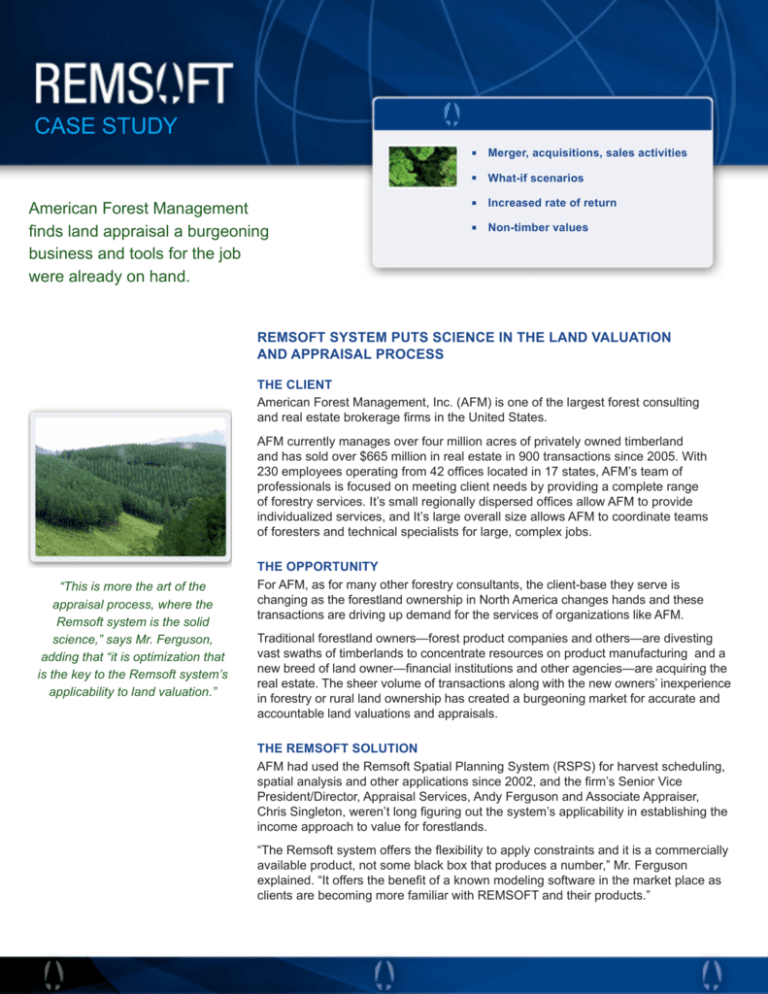AFM Case Study
advertisement

CASE STUDY HIGHLIGHTS CASE STUDY American Forest Management finds land appraisal a burgeoning business and tools for the job were already on hand. n Merger, acquisitions, sales activities n What-if scenarios n Increased rate of return n Non-timber values REMSOFT SYSTEM PUTS SCIENCE IN THE LAND VALUATION AND APPRAISAL PROCESS THE CLIENT American Forest Management, Inc. (AFM) is one of the largest forest consulting and real estate brokerage firms in the United States. AFM currently manages over four million acres of privately owned timberland and has sold over $665 million in real estate in 900 transactions since 2005. With 230 employees operating from 42 offices located in 17 states, AFM’s team of professionals is focused on meeting client needs by providing a complete range of forestry services. It’s small regionally dispersed offices allow AFM to provide individualized services, and It’s large overall size allows AFM to coordinate teams of foresters and technical specialists for large, complex jobs. “This is more the art of the appraisal process, where the Remsoft system is the solid science,” says Mr. Ferguson, adding that “it is optimization that is the key to the Remsoft system’s applicability to land valuation.” THE OPPORTUNITY For AFM, as for many other forestry consultants, the client-base they serve is changing as the forestland ownership in North America changes hands and these transactions are driving up demand for the services of organizations like AFM. Traditional forestland owners—forest product companies and others—are divesting vast swaths of timberlands to concentrate resources on product manufacturing and a new breed of land owner—financial institutions and other agencies—are acquiring the real estate. The sheer volume of transactions along with the new owners’ inexperience in forestry or rural land ownership has created a burgeoning market for accurate and accountable land valuations and appraisals. THE REMSOFT SOLUTION AFM had used the Remsoft Spatial Planning System (RSPS) for harvest scheduling, spatial analysis and other applications since 2002, and the firm’s Senior Vice President/Director, Appraisal Services, Andy Ferguson and Associate Appraiser, Chris Singleton, weren’t long figuring out the system’s applicability in establishing the income approach to value for forestlands. “The Remsoft system offers the flexibility to apply constraints and it is a commercially available product, not some black box that produces a number,” Mr. Ferguson explained. “It offers the benefit of a known modeling software in the market place as clients are becoming more familiar with REMSOFT and their products.” CASE STUDY The system proved so effective for the task, in fact, that it displaced AFM’s own proprietary simulation model as the tool of choice for acquisition analysis. The AFM team will take one or more approaches to valuing timberland—these various approaches are then used to derive an opinion of value. For productive forestland, an Income or Discounted Cash Flow (DCF) approach to appraisal is common. To develop cash flow projections from timber and other resources on the property, AFM’s acquisition and valuations team obtain timber inventory data and format it as development types. They then collect other market-based information, such as timber product pricing, timber product specifications and discount rates. “We then establish the planning period length, usually 25 to 50 years, establish non-timber harvest related income and expenses such as hunting leases, taxes and silviculture treatments, and establish any constraints to apply such as a wood supply agreement tied to the land,” says Mr. Ferguson. Because of the flexibility of the system, AFM is able to include land sales in its long term timber cash flows and even model short-term land dispositions on properties with potential uses beyond timberland. The AFM team uses the Remsoft system’s linear programming-based modeling component, for the modeling aspect of the valuation process, including creating and querying the database and verifying the integrity of data that is provided to them. In addition to running multiple versions of the model, varying objectives and constraints and other criteria, AFM will typically also conduct two other approaches in determining a final timberland appraisal value opinion—a Sales Comparison Approach, where analysts consider what similar lands have sold for, and a Cost or Market Data Approach, that looks at the contributory value of the primary components of a forestland property—land, merchantable timber, premerchantable timber and other improvements—and then sums the components to arrive at a value for the property as a whole. A final number is determined through a reconciliation process that considers the appropriateness of each approach in order to arrive at a final market value opinion. “Optimization technology is a huge advantage because we can apply constraints, such as wood supply agreements, or conservation easement limitations, and with the system’s flexibility, we can easily modify the model, adding in new information as it becomes available or creating actions and transitions, outputs or reports that are meaningful and useful to the problem at hand,” Ferguson says. Because the Remsoft system is widely known and understood in the market, Mr. Ferguson said they have found it has lent additional credibility to AFM’s appraisals. info@remsoft.com www.remsoft.com







